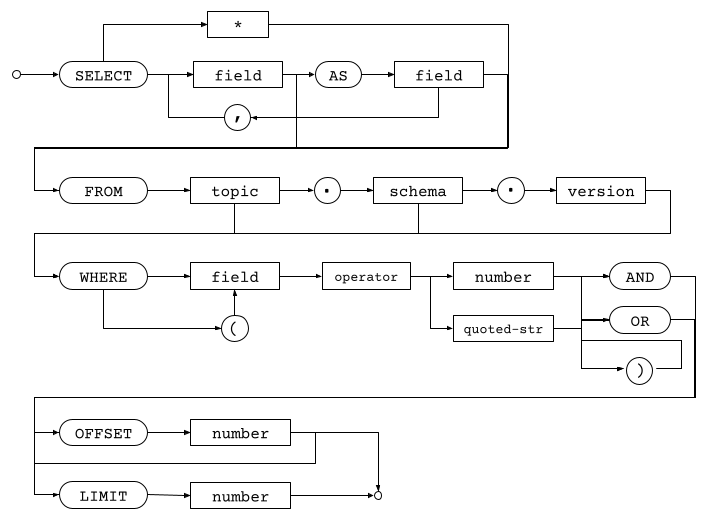Ensign supports querying using standard SELECT statements using the following basic syntax:

SELECT
SELECT is used as to begin an EnSQL statement to query events from a topic.
Syntax is as follows:
SELECT * | { field_name[ AS field_alias] }
To select all fields from a specified topic, you would use:
SELECT * FROM <topic>
However, you can also specify one or more field names with optional aliases to create a projection of the fields that you would like to return. For example, given an event that has the fields id, timestamp, sensor, reading, you can specify only a subset of the fields as follows:
SELECT timestamp, reading FROM <topic>
You can also alias fields in the returned result using AS:
SELECT reading AS sensor_reading FROM <topic>
FROM
Specifies the topic to use in a SELECT statement optionally with the schema and version of an event type in order to support robust queries.
Syntax is as follows:
SELECT ...
FROM <topicReference>
Where:
topicReference := <topic_name>[.<schema_name>[.<schema_version>]]
SELECT statements are required to have a FROM clause.
WHERE
A WHERE clause specifies conditions that act as a filter to ensure that only events that meet the predictate defined by the WHERE clause are returned.
Syntax is as follows:
WHERE <predicate>
Such that:
predicate :=
-- expression
<field> <operator> <value> |
-- logical operator
<expression> <logical operator> <expression> |
-- parenthetical grouping
(<expression> <logical operator> <expression>) <logical operator> <expression>
See Query Operators for more detail on expression and logical operators.
LIMIT
Constrains the maximum number of events returned by a query.
Syntax:
SELECT ...
FROM ...
LIMIT <count>
Where <count> is a numeric value that specifies the maximum number of events returned.
OFFSET
Offset specifies where the query should start in the event stream. While OFFSET is typically used in conjunction with LIMIT, unlike in standard SQL, it is not necessary to specify a LIMIT to use OFFSET since all events are totally ordered.
Syntax:
SELECT ...
FROM ...
OFFSET <start>
Where <start> is one of the following:
- A numeric integer, specifies how far from the beginning of the stream to start returning events. E.g.
OFFSET 100will start returning events afters skipping the first 99 events. - An event ID as a quoted string, specifies a specific event ID to start querying from.
BEFORE | AFTER
Coming soon!
The BEFORE and AFTER statements allows EnSQL users to specify queries relative to time or event ordering. EnSQL does not currently have an ORDER BY clause since data is returned in time ordering; the BEFORE and AFTER statements allow users to traverse events either forward or backward in time.
